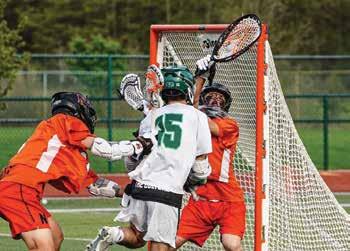
3 minute read
A Crown Jewel Lost
A missing piece of Northville’s architectural history
By Michele Fecht
Advertisement
It seems rather silly to lament the loss of an architectural embellishment I have only laid eyes on in historical photographs. But there it is.
For more than 70 years, the pediment atop 123 East Main Street — now home to The Northville Gallery — provided not only an aesthetic focal point among the rows of north Main Street businesses, but also a directional beacon. Its inscription stated “Union Block” along with its construction date of 1893.
And what was the Union Block? Cities often would name a grouping of street addresses by block. The addresses from 117 to 127 East Main were identified as the Union Block. Northville block names were peppered throughout its commercial district. Blocks might be named for individuals such as the Hirsch Block named for John Hirsch whose blacksmith shop was at the corner of what is now Hutton and Main Street. A replica of the blacksmith shop is in Mill Race Historical Village.
Other block names included the Opera House block located at Dunlap and North
Center. That would later be referred to as The Record block when publisher Frank Neal purchased the opera house and moved The Northville Record office to the site. Owner’s rights.
How the Union Block got its name is elusive. The businesses along that stretch of Main Street at the time of construction ranged from a harness shop, hardware and tin shop to M.N. Johnson & Co. clothiers. The word “Union” could be found elsewhere in the community. Northville’s first high school built in 1865 at the close of the Civil War was aptly named Northville Union School. J. A. Dubuar Manufacturing Company would later change its name to Union Manufacturing and Lumber.
So what of the pediment’s demise?
At the onset of the 1960s — a decade that would herald mid-century modern architecture and a dramatic societal shift — downtown Northville’s commercial district looked to “modernizing” its 19th century structures. And so commenced the covering of bricked facades and dismantling of wooden cornices, partially infilling second-story windows and adding metalframed casements, putting up awnings and installing an array of exterior signage in a veritable hodgepodge of styles.
Among the most notable façade changes were the exteriors of the Union Block buildings including Gambles Hardware Store and the Sally Bell Bakery (later

Foltyn’s Pastry Shoppe). Both structures added metal-framed casement windows to the second floor, modern display windows at street level and eye-popping green metal panels to the second story façade.
A photograph in the August 21,1960 edition of The Northville Record shows workers on the rooftop of 123 East Main Street dismantling its 1893 pediment and cornice in what was described as the building’s “facelift.” Ugh.
By the 1970s, the preservation movement that had taken hold throughout the nation was well under way in Northville. Concern over the loss of historic buildings — most notably the proposed demolition of the former community library on Wing Street to make way for a multi-story indoor mall — was a catalyst for much of the community’s growing preservation efforts. It did not come soon enough to save Northville’s Opera House demolished in 1949 to make way for a city parking lot, but that’s another story.
The 1970s would see Mill Race Historical Village take shape with the first of its historic structures moved to the 12-acre site in 1972. The historical society also surveyed structures in the city’s core finding more than half were more than 50 years old (many much older) and eligible for historic district designation.
The biggest transformation would come with the Mainstreet 78 project, a voter-approved four-year undertaking to revitalize the city’s downtown and reenergize efforts to preserve its historic commercial structures and character. The city also incorporated the Downtown Development Authority to maintain the downtown’s viability.
Suddenly everything old was new again. And so went the green metal panels, the metal-framed casement windows and neon signage at 123 East Main. The building now all but resembles the 1893 structure including the addition of a cornice modeled after the original.
The only thing missing is the pediment — the structure’s crown jewel — and now a lost piece of Northville’s history.

GIRL’S VARSITY SOCCER


BOY’S VARSITY BASEBALL

GIRL’S VARSITY LACROSSE


BOY’S VARSITY LACROSSE

GIRL’S VARSITY TENNIS











